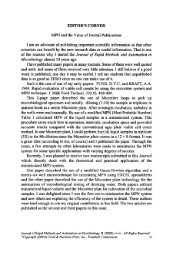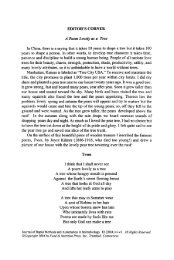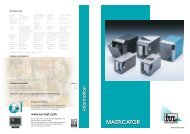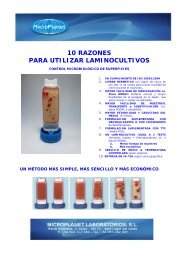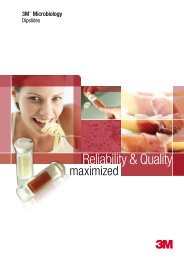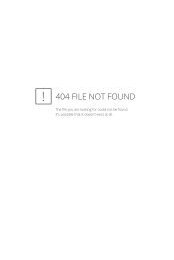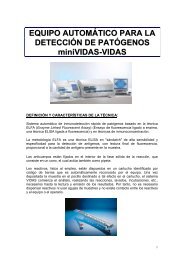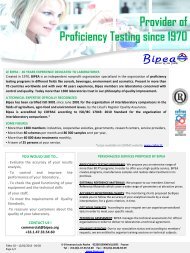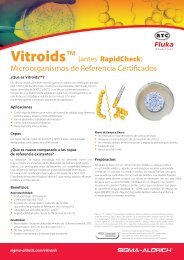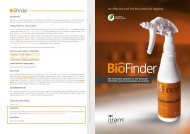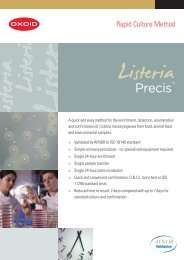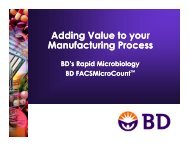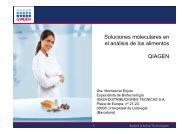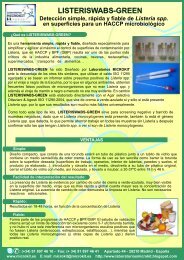Guía de referencia rápida Pseudalert* - Pàgines de la UAB
Guía de referencia rápida Pseudalert* - Pàgines de la UAB
Guía de referencia rápida Pseudalert* - Pàgines de la UAB
Create successful ePaper yourself
Turn your PDF publications into a flip-book with our unique Google optimized e-Paper software.
<strong>Guía</strong> <strong>de</strong> <strong>referencia</strong> <strong>rápida</strong> Pseudalert *<br />
Consejos rápidos para leer los resultados <strong>de</strong> Pseudalert<br />
Después <strong>de</strong> 24 horas <strong>de</strong> incubación a 38 °C ± 0.5 °C (o 26 horas para muestras carbonatadas):<br />
• Lea los resultados usando una lámpara ultravioleta 1 (UV) <strong>de</strong> 6 watt y 365 nm; asegúrese <strong>de</strong> que <strong>la</strong> lámpara tenga <strong>la</strong><br />
longitud <strong>de</strong> onda y <strong>la</strong> intensidad a<strong>de</strong>cuadas.<br />
• Utilice una cámara <strong>de</strong> visualización 2 o lea los resultados en un lugar oscuro para evitar <strong>la</strong> interferencia <strong>de</strong> <strong>la</strong> luz ambiente.<br />
• Interprete toda fluorescencia azul como POSITIVA, aun cuando <strong>la</strong> señal fluorescente sea débil.<br />
• Si no está seguro acerca <strong>de</strong> un pocillo o recipiente que presente fluorescencia débil al cabo <strong>de</strong> 24 horas, incúbelo<br />
durante 1–4 horas más.<br />
Consejos para <strong>la</strong> lectura <strong>de</strong> fluorescencia (vista bajo luz UV)<br />
Lectura cuantitativa con <strong>la</strong> Quanti-Tray* Lectura <strong>de</strong> presencia/ausencia<br />
1 Lámpara UV, catálogo #WL160 (110 V) o #WEA160F (220 V).<br />
2 Cámara <strong>de</strong> visualización UV, catálogo #WCM10.<br />
IDEXX Laboratories, Inc.<br />
One IDEXX Drive, Westbrook, Maine 04092 EE.UU. • 1-800-321-0207 • i<strong>de</strong>xx.com/water<br />
+<br />
–<br />
–<br />
+<br />
+<br />
© 2010 IDEXX Laboratories, Inc. Reservados todos los <strong>de</strong>rechos • 09-68278-00<br />
*Pseudalert y Quanti-Tray son marcas comerciales o marcas comerciales registradas <strong>de</strong> IDEXX Laboratories, Inc. o <strong>de</strong> sus filiales en los Estados Unidos y/u otros países.<br />
La Política <strong>de</strong> Privacidad <strong>de</strong> IDEXX se encuentra disponible en i<strong>de</strong>xx.com.<br />
+<br />
–<br />
–<br />
+<br />
–<br />
Negativo Positivo<br />
– + +<br />
– +<br />
Para obtener más información o hacer un pedido, consulte <strong>la</strong> página i<strong>de</strong>xx.es/pseudalert<br />
En Centroamérica y Latinoamérica, l<strong>la</strong>me al 1-800-321-0207<br />
En España, l<strong>la</strong>me al 93 267 2673
Kit <strong>de</strong> teste <strong>Pseudalert*</strong><br />
Introdução<br />
O teste Pseudalert <strong>de</strong>tecta Pseudomonas aeruginosa em amostras <strong>de</strong> água engarrafada, <strong>de</strong> piscinas ou spas. A base do teste é a <strong>de</strong>tecção <strong>de</strong> uma enzima bacteriana, que assina<strong>la</strong><br />
a presença <strong>de</strong> Pseudomonas aeruginosa ao hidrolisar o substrato presente no reagente Pseudalert. As célu<strong>la</strong>s <strong>de</strong> Pseudomonas aeruginosa crescem rapidamente e se reproduzem<br />
<strong>de</strong>vido às elevadas concentrações <strong>de</strong> aminoácidos, vitaminas e outros nutrientes presentes no reagente para Pseudalert. Cepas <strong>de</strong> Pseudomonas aeruginosa em crescimento ativo<br />
possuem uma enzima que cliva o substrato, produzindo fluorescência azul sob luz UV. Pseudalert <strong>de</strong>tecta Pseudomonas aeruginosa na concentração <strong>de</strong> 1 ufc em amostras <strong>de</strong><br />
100 ml ou 250 ml <strong>de</strong>ntro <strong>de</strong> 24 horas em amostras <strong>de</strong> água não carbonatada e <strong>de</strong>ntro <strong>de</strong> 26 horas em amostras carbonatadas.<br />
Conteúdo<br />
• WPSE020I contém 20 Snap Packs para amostras <strong>de</strong> 100 ml.<br />
• WPSE200I contém 200 Snap Packs para amostras <strong>de</strong> 100 ml.<br />
• WPSE250-20I contém 20 Snap Packs para amostras <strong>de</strong> 250 ml.<br />
• WPSE250-100I contém 100 Snap Packs para amostras <strong>de</strong> 250 ml.<br />
Armazenagem<br />
Armazenar a 2°C–30°C e ao abrigo da luz.<br />
Procedimento para testes <strong>de</strong> presença/ausência (P/A) em amostras <strong>de</strong> água não carbonatada<br />
1. Adicione o conteúdo <strong>de</strong> um snap pack <strong>de</strong> tamanho apropriado a uma amostra <strong>de</strong> 100 ou 250 ml em um recipiente estéril,<br />
transparente e não fluorescente.<br />
2. Tampe o recipiente e agite.<br />
3. Incube a 38°C ± 0,5°C por 24 horas. Os resultados serão válidos por até 28 horas.<br />
4. Leia os resultados conforme a tabe<strong>la</strong> Interpretação <strong>de</strong> resultados apresentada abaixo.<br />
Procedimento para testes <strong>de</strong> presença/ausência (P/A) em amostras <strong>de</strong> água carbonatada<br />
1. Desgaseifique a amostra agitando-a vigorosamente no recipiente original até que não haja mais gás visível ou audível (solte a tampa<br />
para permitir a saída do gás após agitar).<br />
2. Adicione o conteúdo <strong>de</strong> um snap pack <strong>de</strong> tamanho apropriado a uma amostra <strong>de</strong> 100 ou 250 ml em um recipiente estéril,<br />
transparente e não fluorescente.<br />
3. Agite vigorosamente o recipiente durante 30–60 segundos para liberar o gás carbônico (afrouxe a tampa para permitir a saída do gás<br />
<strong>de</strong>pois <strong>de</strong> agitar).<br />
4. Recoloque a tampa e coloque o recipiente em um banho-maria a 38°C ± 0,5°C por 20 minutos.<br />
5. Agite vigorosamente o recipiente até que não haja mais gás visível ou audível (afrouxe a tampa para permitir a saída do gás <strong>de</strong>pois <strong>de</strong> agitar).<br />
6. Recoloque a tampa e coloque em banho-maria a 38°C ± 0,5°C por 26 horas. Os resultados serão válidos por até 28 horas.<br />
7. Leia os resultados conforme a tabe<strong>la</strong> Interpretação <strong>de</strong> resultados apresentada abaixo.<br />
Procedimento <strong>de</strong> enumeração Quanti-Tray* (somente amostras <strong>de</strong> 100 ml)<br />
Observação: Ao testar amostras <strong>de</strong> água carbonatada engarrafada, siga as etapas 1–3 do “Procedimento para testes <strong>de</strong> presença/ausência<br />
(P/A) em amostras <strong>de</strong> água carbonatada” e, em seguida, siga a etapa 3 abaixo.<br />
1. Adicione o conteúdo <strong>de</strong> um snap pack a uma amostra <strong>de</strong> água <strong>de</strong> 100 ml em um recipiente estéril.<br />
2. Tampe o recipiente e agite até dissolver.<br />
3. Adicione 2 gotas da solução antiespuma IDEXX 1 à mistura <strong>de</strong> amostra/reagente.<br />
Observação: Também estão disponíveis recipientes <strong>de</strong> amostras IDEXX <strong>de</strong> 120 ml com antiespuma. 2<br />
4. Coloque a mistura <strong>de</strong> amostra/reagente em uma Quanti-Tray ou Quanti-Tray/2000 e ve<strong>de</strong> com um se<strong>la</strong>dor Quanti-Tray.<br />
5. Coloque a p<strong>la</strong>ca se<strong>la</strong>da em banho-maria a 38°C ± 0,5°C por 24 horas (26 horas para água carbonatada). Os resultados serão válidos por até 28 horas.<br />
6. Leia os resultados conforme a tabe<strong>la</strong> Interpretação <strong>de</strong> resultados apresentada abaixo. Conte o número <strong>de</strong> cavida<strong>de</strong>s positivas e consulte a tabe<strong>la</strong> <strong>de</strong> número mais provável<br />
(NMP) fornecida com as p<strong>la</strong>cas para verificar o número mais provável.<br />
Interpretação do resultado<br />
Aspecto Resultado<br />
Sem fluorescência azul Negativo para Pseudomonas aeruginosa<br />
Fluorescência azul † Positivo para Pseudomonas aeruginosa<br />
† Presença <strong>de</strong> fluorescência azul em quantida<strong>de</strong> superior à observada na amostra <strong>de</strong> controle negativo.<br />
• Para pesquisar fluorescência azul, coloque uma lâmpada UV <strong>de</strong> 6 watts e 365 nm a aproximadamente 12 cm da amostra em um ambiente escuro. Aponte a luz para amostra<br />
e na direção oposta a seus olhos.<br />
• Os Pseudalert dá resultados <strong>de</strong>finitivos em 24–28 horas para amostras não carbonatadas. Além disso, resultados positivos para Pseudomonas aeruginosa observados antes<br />
<strong>de</strong> 24 horas e negativos observados após 28 horas também são válidos.<br />
Observações sobre o procedimento<br />
• Use apenas água estéril, não tamponada e sem oxidantes para as diluições.<br />
• Para comparação, po<strong>de</strong>-se utilizar um branco incubado <strong>de</strong> água estéril contendo o reagente Pseudalert (controle negativo) ao interpretar os resultados.<br />
• Estas instruções po<strong>de</strong>m não ser inteiramente compatíveis com os regu<strong>la</strong>mentos cabíveis em seu local <strong>de</strong> trabalho. Para manter a conformida<strong>de</strong>, verifique se os<br />
procedimentos regu<strong>la</strong>tórios cabíveis estão sendo seguidos.<br />
• Pseudalert é um teste para água primária. As características do <strong>de</strong>sempenho do Pseudalert não se aplicam a amostras alteradas por pré-enriquecimento ou concentração.<br />
• O Pseudalert não foi validado para uso com amostras <strong>de</strong> água engarrafada aromatizada ou água do mar.<br />
• Empregue sempre técnicas assépticas ao utilizar o Pseudalert. Descarte os materiais <strong>de</strong> acordo com as boas práticas <strong>la</strong>boratoriais.<br />
• A presença <strong>de</strong> altas concentrações <strong>de</strong> minerais, especialmente magnésio ou cálcio, po<strong>de</strong> turvar o reagente Pseudalert.<br />
Procedimientos <strong>de</strong> control <strong>de</strong> calidad<br />
Os procedimentos <strong>de</strong> controle <strong>de</strong> qualida<strong>de</strong> a seguir são recomendados para cada lote <strong>de</strong> Pseudalert e <strong>de</strong>vem ser realizados com mais frequência se exigido pe<strong>la</strong><br />
regu<strong>la</strong>mentação:<br />
1. Para cada cepa bacteriana do American Type Culture Collection (ATCC) 3 listada abaixo, repique a cultura em p<strong>la</strong>cas TSA ou ágar-sangue i<strong>de</strong>ntificadas e incube a 35°C ± 0,5°C<br />
por 18–24 horas.<br />
2. Para cada cepa bacteriana, toque a colônia com uma alça <strong>de</strong> inocu<strong>la</strong>ção estéril <strong>de</strong> 1 μl e utilize-a para inocu<strong>la</strong>r um tubo <strong>de</strong> ensaio i<strong>de</strong>ntificado contendo 5 ml <strong>de</strong> água<br />
<strong>de</strong>ionizada estéril. Feche a tampa e agite vigorosamente.<br />
3. Para cada cepa bacteriana, pegue uma alça <strong>de</strong> 1 μl do tubo <strong>de</strong> ensaio e use-a para inocu<strong>la</strong>r um recipiente i<strong>de</strong>ntificado contendo 100 ou 250 ml <strong>de</strong> água <strong>de</strong>ionizada estéril.<br />
Esses tubos servirão como controles.<br />
4. Para testar os controles, siga as etapas abaixo dos testes <strong>de</strong> Presença/Ausência Pseudalert ou Quanti-Tray Enumeration. Compare os resultados obtidos com os esperados a seguir.<br />
Controle Nº. ATCC Resultado esperado<br />
P. aeruginosa ATCC 27853 ou ATCC 10145 Fluorescência azul<br />
E. coli ATCC 25922 Sem fluorescência azul<br />
P. fluorescens ATCC 13525 Sem fluorescência azul<br />
1. Número <strong>de</strong> catálogo da solução antiespuma IDEXX: WAFDB<br />
2. Número <strong>de</strong> catálogo <strong>de</strong> recipientes IDEXX 120 ml com <strong>la</strong>cre encolhível e antiespuma: WV120SBAF-200<br />
3. American Type Culture Collection, 1-800-638-6597<br />
©2010 IDEXX Laboratories, Inc. Todos os direitos reservados.<br />
*Pseudalert e Quanti-Tray são marcas comerciais ou marcas comerciais registradas da IDEXX Laboratories, Inc. ou <strong>de</strong> suas filiais nos Estados Unidos<br />
da América e/ou em outros países.<br />
<strong>Pseudalert*</strong> Testkit<br />
Einleitung<br />
Der Pseudalert-Test weist Pseudomonas aeruginosa in Wasser in verschlossenen Behältnissen, Schwimmbeckenwasser und Spa-Wasser nach. Der Test basiert auf <strong>de</strong>m<br />
Nachweis bakterieller Enzyme und zeigt das Vorliegen von Pseudomonas aeruginosa durch Hydrolyse eines im Pseudalert-Reagenz enthaltenen Substrats an. Die Zellen von<br />
Pseudomonas aeruginosa wachsen und reproduzieren sich rasch, in<strong>de</strong>m sie <strong>de</strong>n hohen Gehalt an Aminosäuren, Vitaminen und an<strong>de</strong>ren Nährstoffen im Pseudalert-Reagenz<br />
nutzen. Aktiv wachsen<strong>de</strong> Stämme von Pseudomonas aeruginosa weisen ein Enzym auf, dass das Substrat <strong>de</strong>s Reagenz spaltet und im UV-Licht eine b<strong>la</strong>ue Fluoreszenz bewirkt.<br />
Pseudalert weist Pseudomonas aeruginosa im Bereich von 1 CFU (koloniebil<strong>de</strong>n<strong>de</strong> Einheit/KBE) in 100-ml- o<strong>de</strong>r 250-ml-Proben nicht kohlensäurehaltigen Wassers binnen<br />
24 Stun<strong>de</strong>n und in Proben mit kohlensäurehaltigem Wasser innerhalb von 26 Stun<strong>de</strong>n nach.<br />
Inhalt<br />
• WPSE020I enthält 20 Snap Packs für 100-ml-Wasserproben.<br />
• WPSE0200I enthält 200 Snap Packs für 100-ml-Wasserproben.<br />
• WPSE250-20I enthält 20 Snap Packs für 250-ml-Wasserproben.<br />
• WPSE250-100I enthält 100 Snap Packs für 250-ml-Wasserproben.<br />
Lagerung<br />
Bei 2–30 °C lichtgeschützt <strong>la</strong>gern.<br />
Presence/Absence (P/A)-Verfahren für nicht kohlensäurehaltige Wasserproben<br />
1. Den Inhalt eines entsprechend großen Snap Packs zu 100 ml o<strong>de</strong>r 250 ml Wasserprobe geben, die sich in einem sterilen,<br />
transparenten und nicht fluoreszieren<strong>de</strong>n Gefäß befin<strong>de</strong>t.<br />
2. Gefäß verschließen und schütteln.<br />
3. Bei 38 °C ± 0,5 °C 24 Stun<strong>de</strong>n inkubieren; Ergebnisse sind bis zu einer Gesamtinkubationszeit von 28 Stun<strong>de</strong>n gültig.<br />
4. Die Testergebnisse gemäß <strong>de</strong>r nachstehen<strong>de</strong>n Tabelle zur Ergebnisinterpretation ablesen.<br />
Presence/Absence (P/A)-Verfahren für kohlensäurehaltige Wasserproben<br />
1. Kohlensäure aus <strong>de</strong>r Probe durch kräftiges Schütteln <strong>de</strong>s Originalbehältnisses so <strong>la</strong>nge entfernen, bis kein Gas mehr zu sehen o<strong>de</strong>r<br />
zu hören ist (Verschlusskappe immer wie<strong>de</strong>r öffnen, um das Gas nach <strong>de</strong>m Schütteln entweichen zu <strong>la</strong>ssen).<br />
2. Den Inhalt eines entsprechend großen Snap Packs zu 100 ml o<strong>de</strong>r 250 ml Wasserprobe geben, die sich in einem sterilen,<br />
transparenten und nicht fluoreszieren<strong>de</strong>n Gefäß befin<strong>de</strong>t.<br />
3. Das verschlossene Probengefäß 30 bis 60 Sekun<strong>de</strong>n <strong>la</strong>ng schütteln, um die restliche Kohlensäure zu entfernen (Gefäßverschluss öffnen,<br />
um das Gas nach <strong>de</strong>m Schütteln entweichen zu <strong>la</strong>ssen).<br />
4. Verschlusskappe schließen und Gefäß für 20 Minuten in ein Wasserbad mit einer Temperatur von 38 °C ± 0,5 °C geben.<br />
5. Das verschlossene Probengefäß nochmals kräftig schütteln, bis keine Kohlensäure mehr zu sehen o<strong>de</strong>r zu hören ist (Gefäßverschluss öffnen,<br />
um das Gas nach <strong>de</strong>m Schütteln entweichen zu <strong>la</strong>ssen).<br />
6. Verschlusskappe schließen und das Gefäß für weitere 26 Stun<strong>de</strong>n in ein Wasserbad mit 38 °C ± 0,5 °C stellen; Ergebnisse sind bis zu 28 Stun<strong>de</strong>n gültig.<br />
7. Die Testergebnisse gemäß <strong>de</strong>r nachstehen<strong>de</strong>n Tabelle zur Ergebnisinterpretation ablesen.<br />
Quanti-Tray* Verfahren zur quantitativen Bakterienzählung (nur für 100-ml-Proben)<br />
Hinweis: Zum Testen von Proben kohlensäurehaltigen F<strong>la</strong>schenwassers <strong>de</strong>n Anweisungen unter „Presence/Absence (P/A)-Verfahren für<br />
kohlensäurehaltige Wasserproben”, Schritte 1 bis 3 (siehe oben), folgen, danach mit <strong>de</strong>m nachstehen<strong>de</strong>n Schritt 3 fortfahren.<br />
1. Den Inhalt eines Snap Pack zu einer 100-ml-Wasserprobe in einem sterilen Gefäß geben.<br />
2. Gefäß verschließen und schütteln, bis das Reagenz vollkommen aufgelöst ist.<br />
3. Zwei Tropfen IDEXX Antischaum-Lösung 1 zur Mischung aus Probe und Reagenz hinzufügen.<br />
Hinweis: Ebenfalls erhältlich sind IDEXX 120-ml-Probengefäße, die bereits Antischaummittel enthalten. 2<br />
4. Die Mischung aus Probe und Reagenz in einen Quanti-Tray o<strong>de</strong>r Quanti-Tray/2000 gießen und im Quanti-Tray Sealer versiegeln.<br />
5. Den versiegelten Quanti-Tray bei 38 °C ± 0,5 °C 24 Stun<strong>de</strong>n inkubieren (26 Stun<strong>de</strong>n für kohlensäurehaltige Wasserproben); Ergebnisse sind bis zu 28 Stun<strong>de</strong>n gültig.<br />
6. Die Testergebnisse anhand <strong>de</strong>r nachstehen<strong>de</strong>n Tabelle zur Ergebnisinterpretation ablesen. Die Anzahl <strong>de</strong>r positiven Probenvertiefungen zählen und die wahrscheinlichste<br />
Zahl (MPN/Most Probable Number) an Keimen anhand <strong>de</strong>r MPN-Tabelle, die <strong>de</strong>n Trays beiliegt, ermitteln.<br />
Ergebnisinterpretation<br />
Färbung Ergebnis<br />
Keine b<strong>la</strong>ue Fluoreszenz Negativ für Pseudomonas aeruginosa<br />
B<strong>la</strong>ue Fluoreszenz † Positiv für Pseudomonas aeruginosa<br />
† Vorliegen einer stärkeren b<strong>la</strong>u fluoreszieren<strong>de</strong>n Färbung als in <strong>de</strong>r Negativkontrolle<br />
• Untersuchung auf Fluoreszenz in dunklem Umfeld mittels einer 6-Watt-UV-Lampe (365 nm Wellenlänge), die nicht weiter als 12 cm von <strong>de</strong>r Probe entfernt sein soll. Das Licht<br />
nicht in die Augen, son<strong>de</strong>rn auf die Probe richten.<br />
• Pseudalert-Testergebnisse sind für nicht kohlensäurehaltige Proben nach 24–28 Stun<strong>de</strong>n <strong>de</strong>finitiv. Auch die vor Ab<strong>la</strong>uf von 24 Stun<strong>de</strong>n beobachteten positiven sowie die nach<br />
Ab<strong>la</strong>uf von 28 Stun<strong>de</strong>n beobachteten negativen Reaktionen auf Pseudomonas aeruginosa sind gültige Ergebnisse.<br />
Hinweise zur Testdurchführung<br />
• Nur steriles, nicht gepuffertes, keine Oxidanzien enthalten<strong>de</strong>s Wasser zur Verdünnung verwen<strong>de</strong>n.<br />
• Zum Vergleich kann zur Ergebnisinterpretation eine inkubierte Blindprobe aus sterilem Wasser, dass das Pseudalert-Reagenz enthält (Negativkontrolle), herangezogen wer<strong>de</strong>n.<br />
• Manche Angaben in dieser Packungsbei<strong>la</strong>ge entsprechen möglicherweise nicht Ihren örtlichen Vorschriften. Stellen Sie sicher, dass die anwendbaren behördlichen<br />
Vorschriften befolgt wer<strong>de</strong>n.<br />
• Pseudalert ist ein primärer Wassertest. Die Leistungsmerkmale für Pseudalert gelten nicht für Proben, die durch Voranreicherung o<strong>de</strong>r Konzentration modifiziert wur<strong>de</strong>n.<br />
• Pseudalert ist nicht für die Verwendung bei Wasserproben von mit Geschmack versetztem F<strong>la</strong>schenwasser o<strong>de</strong>r Meerwasser validiert.<br />
• Bei <strong>de</strong>r Verwendung von Pseudalert sollte stets auf ein aseptisches Vorgehen geachtet wer<strong>de</strong>n. Entsorgung <strong>de</strong>r Materialien gemäß <strong>de</strong>n Standard-Laborpraktiken (Gute Laborpraxis/GLP).<br />
• Bei hohem Mineralstoffgehalt <strong>de</strong>s Wassers (insbeson<strong>de</strong>re von Magnesium o<strong>de</strong>r Kalzium) kann sich das Pseudalert-Reagenz trüben.<br />
Qualitätskontrollverfahren<br />
Für je<strong>de</strong> Charge von Pseudalert (bzw. auch häufiger, je nach örtlichen Bestimmungen) müssen die folgen<strong>de</strong>n Verfahren zur Qualitätskontrolle angewen<strong>de</strong>t wer<strong>de</strong>n:<br />
1. Für je<strong>de</strong>n Bakterienstamm <strong>de</strong>r American Type Culture Collection (ATTC) 3 , <strong>de</strong>r unten aufgeführt ist, die Kultur auf markierte TSA- o<strong>de</strong>r Blutagarp<strong>la</strong>tten ausstreichen und bei<br />
35 °C ± 0,5 °C 18–24 Stun<strong>de</strong>n inkubieren.<br />
2. Für je<strong>de</strong>n Bakterienstamm 1 μl einer Kolonie mittels steriler Inoku<strong>la</strong>tionsöse in ein markiertes Teströhrchen mit 5 ml sterilen, entionisierten Wassers transferieren. Röhrchen<br />
verschließen und kräftig schütteln.<br />
3. Für je<strong>de</strong>n Bakterienstamm 1 μl mittels geeigneter Inoku<strong>la</strong>tionsöse aus <strong>de</strong>m Teströhrchen entnehmen und in ein markiertes Gefäß mit 100 ml o<strong>de</strong>r 250 ml sterilen,<br />
entionisierten Wassers überführen. Dies sind die Kontrollen.<br />
4. Folgen Sie zum Testen dieser Kontrollen <strong>de</strong>n Anweisungen <strong>de</strong>r oben beschriebenen Schritte <strong>de</strong>s Pseudalert Presence/Absence-Verfahrens o<strong>de</strong>r <strong>de</strong>s Quanti-Tray-Verfahrens<br />
zur quantitativen Bakterienzählung. Vergleichen Sie die Testergebnisse mit <strong>de</strong>n nachfolgen<strong>de</strong>n erwarteten Resultaten.<br />
Kontrolle ATCC Nr Erwartetes Resultat<br />
P. aeruginosa ATCC 27853 o<strong>de</strong>r ATCC 10145 B<strong>la</strong>ue Fluoreszenz<br />
E. coli ATCC 25922 Keine b<strong>la</strong>ue Fluoreszenz<br />
P. fluorescens ATCC 13525 Keine b<strong>la</strong>ue Fluoreszenz<br />
1. IDEXX Antischaum-Lösung - Katalognummer: WAFDB<br />
2. IDEXX mit Schrumpfband verschlossene Einwegbehälter (120 ml) mit Antischaum-Lösung - Katalognummer: WV120SBAF-200<br />
3. American Type Culture Collection 1-800-638-6597<br />
©2010 IDEXX Laboratories, Inc. Alle Rechte vorbehalten.<br />
*Pseudalert und Quanti-Tray sind Schutzmarken o<strong>de</strong>r eingetragene Schutzmarken von IDEXX Laboratories, Inc. o<strong>de</strong>r eines Tochterunternehmens von IDEXX<br />
in <strong>de</strong>n Vereinigten Staaten und/o<strong>de</strong>r in an<strong>de</strong>ren Län<strong>de</strong>rn.<br />
Pseudalert *<br />
06-18569-01<br />
IDEXX Laboratories, Inc., One IDEXX Drive, Westbrook, Maine 04092 USA<br />
North/South America: 1-207-556-4496/1-800-321-0207<br />
For Technical Support, please call:<br />
www.i<strong>de</strong>xx.com/water<br />
UK: +44 (0) 1638 676800<br />
Europe: 00800 4339 9111<br />
China: +86-21-61279528<br />
Japan: +81 422 71 5921<br />
Australia: 1800 655 978
<strong>Pseudalert*</strong> Test Kit<br />
Introduction<br />
The Pseudalert test <strong>de</strong>tects the presence of Pseudomonas aeruginosa in bottled-, pool-, and spa- water samples. The test is based on a bacterial enzyme <strong>de</strong>tection technology<br />
that signals the presence of Pseudomonas aeruginosa through the hydrolysis of a substrate present in the Pseudalert reagent. Pseudomonas aeruginosa cells rapidly grow and<br />
reproduce using the rich supply of amino acids, vitamins, and other nutrients present in the Pseudalert reagent. Actively growing strains of Pseudomonas aeruginosa have an<br />
enzyme that cleaves the substrate to produce a blue fluorescence un<strong>de</strong>r UV light. Pseudalert <strong>de</strong>tects Pseudomonas aeruginosa at 1 cfu in either 100 mL or 250 mL samples<br />
within 24 hours for non-carbonated water samples and within 26 hours for carbonated samples.<br />
Contents<br />
• WPSE020I contains 20 Snap Packs for 100 mL samples.<br />
• WPSE200I contains 200 Snap Packs for 100 mL samples.<br />
• WPSE250-20I contains 20 Snap Packs for 250 mL samples.<br />
• WPSE250-100I contains 100 Snap Packs for 250 mL samples.<br />
Storage<br />
Store at 2°C–30°C away from light<br />
Presence/Absence (P/A) Procedure for Non-carbonated Water Samples<br />
1. Add contents of one appropriately sized snap pack to either a 100 mL or 250 mL sample in a sterile, transparent,<br />
nonfluorescing vessel.<br />
2. Cap vessel and shake.<br />
3. Incubate at 38°C ±0.5°C for 24 hours; results are valid up to 28 hours.<br />
4. Read results according to Result Interpretation table below.<br />
Presence/Absence (P/A) Procedure for Carbonated Water Samples<br />
1. De-gas sample by vigorously shaking sample in original container until no gas can be seen or heard<br />
(loosen cap to allow gas to escape after shaking).<br />
2. Add contents of one appropriately sized snap pack to either a 100 mL or 250 mL sample in a sterile, transparent, nonfluorescing vessel.<br />
3. Shake vessel vigorously for 30–60 seconds to release carbonation (loosen cap to allow gas to<br />
escape after shaking).<br />
4. Secure cap and p<strong>la</strong>ce vessel in 38°C ±0.5°C water bath for 20 minutes.<br />
5. Shake vessel vigorously until no gas can be seen or heard to release carbonation (loosen cap to allow gas<br />
to escape after shaking).<br />
6. Secure cap and p<strong>la</strong>ce in a 38°C ±0.5°C water bath for 26 hours; results are valid up to 28 hours.<br />
7. Read results according to Result Interpretation table below.<br />
Quanti-Tray* Enumeration Procedure (100 mL Samples Only)<br />
Note: If testing carbonated bottled-water samples, follow the “Presence/Absence (P/A) Procedure for<br />
Carbonated Water Samples” steps 1–3 (above), then proceed to step 3 below.<br />
1. Add contents of one snap pack to a 100 mL water sample in a sterile vessel.<br />
2. Cap vessel and shake until dissolved.<br />
3. Add 2 drops of IDEXX Antifoam Solution 1 to the sample/reagent mixture.<br />
Note: IDEXX 120 mL sample vessels 2 containing antifoam are also avai<strong>la</strong>ble.<br />
4. Pour sample/reagent mixture into a Quanti-Tray or Quanti-Tray/2000 and seal in a Quanti-Tray Sealer.<br />
5. P<strong>la</strong>ce the sealed tray in a 38°C ±0.5°C incubator for 24 hours (26 hours for carbonated samples); results are valid up to 28 hours.<br />
6. Read results according to the Result Interpretation table below. Count the number of positive wells, and refer to the MPN table provi<strong>de</strong>d with the trays to obtain a Most<br />
Probable Number.<br />
Result Interpretation<br />
Appearance Result<br />
No blue fluorescence Negative for Pseudomonas aeruginosa<br />
Blue fluorescence † Positive for Pseudomonas aeruginosa<br />
† Presence of blue fluorescent color greater than the amount present in a negative control sample<br />
• Look for fluorescence with a 6-watt, 365 nm, UV light within 5 inches of the sample in a dark environment. Face light away from your eyes and toward the sample.<br />
• Pseudalert results are <strong>de</strong>finitive at 24–28 hours for non-carbonated samples. In addition, positives for Pseudomonas aeruginosa observed before 24 hours and negatives<br />
observed after 28 hours are also valid.<br />
Procedural Notes<br />
• Use only sterile, nonbuffered, oxidant-free water for dilutions.<br />
• For comparison, an incubated sterile water b<strong>la</strong>nk containing Pseudalert reagent (negative control) can be used when interpreting results.<br />
• This insert may not reflect your local regu<strong>la</strong>tions. For compliance testing, be sure to follow appropriate regu<strong>la</strong>tory procedures.<br />
• Pseudalert is a primary water test. Pseudalert performance characteristics do not apply to samples altered by preenrichment or concentration.<br />
• Pseudalert has not been validated for use with f<strong>la</strong>vored bottled-water or marine water samples.<br />
• Aseptic technique should always be followed when using Pseudalert. Dispose of materials in accordance with Good Laboratory Practices.<br />
• The presence of a high mineral content (especially magnesium and or calcium) can cause Pseudalert reagent to become cloudy.<br />
Quality Control Procedures<br />
The following quality control procedure is recommen<strong>de</strong>d for each lot of Pseudalert or more often as regu<strong>la</strong>tions require:<br />
1. For each of the American Type Culture Collection (ATCC) 3 bacterial strain listed below, streak the culture onto <strong>la</strong>beled TSA or blood agar p<strong>la</strong>tes, and incubate at 35°C<br />
±0.5°C for 18–24 hours.<br />
2. For each bacterial strain, touch a sterile 1 μL inocu<strong>la</strong>ting loop to a colony, and use it to inocu<strong>la</strong>te a <strong>la</strong>beled test tube containing 5 mL of sterile <strong>de</strong>ionized water. Close cap<br />
and shake thoroughly.<br />
3. For each bacterial strain, take a 1 μL loop from the test tube, and use it to inocu<strong>la</strong>te a <strong>la</strong>beled vessel containing either 100 mL or 250 mL of sterile <strong>de</strong>ionized water. These<br />
are your controls.<br />
4. Follow the Pseudalert Presence/Absence or Quanti-Tray Enumeration steps above to test these controls. Compare test results to the expected results below.<br />
Control ATCC # Expected Result<br />
P. aeruginosa ATCC 27853 or ATCC 10145 Blue fluorescence<br />
E. coli ATCC 25922 No blue fluorescence<br />
P. fluorescens ATCC 13525 No blue fluorescence<br />
1. IDEXX Antifoam Solution catalog number: WAFDB<br />
2. IDEXX 120 mL Shrink-ban<strong>de</strong>d Vessels with Antifoam catalog number: WV120SBAF-200<br />
3. American Type Culture Collection, 1-800-638-6597<br />
©2010 IDEXX Laboratories, Inc. All rights reserved.<br />
*Pseudalert and Quanti-Tray are tra<strong>de</strong>marks or registered tra<strong>de</strong>marks of IDEXX Laboratories, Inc. or its affiliates in the United States and/or other countries.<br />
Kit <strong>de</strong> test <strong>Pseudalert*</strong><br />
Introduction<br />
Le test Pseudalert détecte <strong>la</strong> présence <strong>de</strong> Pseudomonas aeruginosa dans les échantillons d’eau en bouteille, d’eau <strong>de</strong> piscine et d’eau thermale. Le test est basé sur <strong>la</strong><br />
détection d’une enzyme bactérienne qui, en hydrolysant le substrat présent dans le réactif Pseudalert, met en évi<strong>de</strong>nce <strong>la</strong> présence <strong>de</strong> <strong>la</strong> bactérie Pseudomonas aeruginosa.<br />
Avec le milieu enrichi en aci<strong>de</strong>s aminés, vitamines et autres nutriments présents dans le réactif Pseudalert, <strong>la</strong> croissance et <strong>la</strong> reproduction <strong>de</strong> Pseudomonas aeruginosa<br />
sont rapi<strong>de</strong>s. Les souches <strong>de</strong> Pseudomonas aeruginosa en pleine croissance expriment une enzyme qui clive le substrat, ce qui produit une fluorescence bleue visible sous<br />
lumière ultraviolette. Pseudalert détecte Pseudomonas aeruginosa à 1 ufc dans <strong>de</strong>s échantillons <strong>de</strong> 100 ml ou <strong>de</strong> 250 ml en 24 heures pour les échantillons d’eau non<br />
gazeuse et en 26 heures pour les échantillons d’eau gazeuse.<br />
Contenu<br />
• WPSE020I contient 20 sachets Snap pour <strong>de</strong>s échantillons <strong>de</strong> 100 ml.<br />
• WPSE200I contient 200 sachets Snap pour <strong>de</strong>s échantillons <strong>de</strong> 100 ml.<br />
• WPSE250-20I contient 20 sachets Snap pour <strong>de</strong>s échantillons <strong>de</strong> 250 ml.<br />
• WPSE250-100I contient 100 sachets Snap pour <strong>de</strong>s échantillons <strong>de</strong> 250 ml.<br />
Conditions <strong>de</strong> conservation<br />
À conserver entre 2 °C et 30 °C, à l’abri <strong>de</strong> <strong>la</strong> lumière.<br />
Procédure <strong>de</strong> présence/absence (P/A) pour les échantillons d’eau non gazeuse<br />
1. Ajouter le contenu d’un sachet Snap <strong>de</strong> taille appropriée dans un échantillon <strong>de</strong> 100 ml ou <strong>de</strong> 250 ml p<strong>la</strong>cé dans un récipient<br />
stérile, transparent et non fluorescent.<br />
2. Fermer le récipient et agiter.<br />
3. Incuber à 38 °C ± 0,5 °C pendant 24 heures. Les résultats peuvent être lus jusqu’à 28 heures.<br />
4. Interpréter les résultats en se référant au tableau d’interprétation <strong>de</strong>s résultats ci-<strong>de</strong>ssous.<br />
Procédure <strong>de</strong> présence/absence (P/A) pour les échantillons d’eau gazeuse<br />
1. Dégazer l’échantillon en agitant vigoureusement le récipient dans lequel il a été prélevé jusqu’à ce qu’il soit impossible <strong>de</strong> voir ou<br />
d’entendre le gaz (<strong>de</strong>sserrer le bouchon pour permettre au gaz <strong>de</strong> s’échapper après l’agitation).<br />
2. Ajouter le contenu d’un sachet Snap <strong>de</strong> taille appropriée dans un échantillon <strong>de</strong> 100 ml ou <strong>de</strong> 250 ml p<strong>la</strong>cé dans un récipient stérile,<br />
transparent et non fluorescent.<br />
3. Agiter le récipient vigoureusement pendant 30 à 60 secon<strong>de</strong>s pour libérer <strong>la</strong> carbonatation (<strong>de</strong>sserrer le bouchon pour permettre au gaz<br />
<strong>de</strong> s’échapper après l’agitation).<br />
4. Refermer le récipient et le p<strong>la</strong>cer dans un bain-marie à 38 °C ± 0,5 °C pendant 20 minutes.<br />
5. Agiter le récipient vigoureusement pour libérer <strong>la</strong> carbonatation jusqu’à ce qu’il soit impossible <strong>de</strong> voir ou d’entendre le gaz (<strong>de</strong>sserrer le<br />
bouchon pour permettre au gaz <strong>de</strong> s’échapper après l’agitation).<br />
6. Refermer le récipient et le p<strong>la</strong>cer dans un bain-marie à 38 °C ± 0,5 °C pendant 26 heures. Les résultats peuvent être lus jusqu’à 28 heures.<br />
7. Interpréter les résultats en se référant au tableau d’interprétation <strong>de</strong>s résultats ci-<strong>de</strong>ssous.<br />
Procédure <strong>de</strong> numération Quanti-Tray* (échantillons <strong>de</strong> 100 ml uniquement)<br />
Remarque : Si l’analyse concerne <strong>de</strong>s échantillons d’eau gazeuse en bouteille, suivre les étapes 1 à 3 <strong>de</strong> <strong>la</strong> « Procédure <strong>de</strong> présence/<br />
absence (P/A) pour les échantillons d’eau gazeuse » ci-<strong>de</strong>ssus, puis passer directement à l’étape 3 ci-<strong>de</strong>ssous.<br />
1. Ajouter le contenu d’un sachet Snap dans un échantillon d’eau <strong>de</strong> 100 ml p<strong>la</strong>cé dans un récipient stérile.<br />
2. Fermer le récipient et agiter jusqu’à dissolution.<br />
3. Ajouter 2 gouttes <strong>de</strong> solution anti-mousse IDEXX 1 au mé<strong>la</strong>nge échantillon/réactif.<br />
Remarque : <strong>de</strong>s récipients IDEXX <strong>de</strong> 120 ml contenant déjà un agent anti-mousse sont également disponibles. 2<br />
4. Verser le mé<strong>la</strong>nge échantillon/réactif dans un Quanti-Tray ou Quanti-Tray/2000 et fermer hermétiquement à l’ai<strong>de</strong> d’une scelleuse Quanti-Tray Sealer.<br />
5. P<strong>la</strong>cer le p<strong>la</strong>teau scellé dans un incubateur à 38 °C ± 0,5 °C pendant 24 heures (26 heures pour les échantillons d’eau gazeuse). Les résultats peuvent être lus jusqu’à 28 heures.<br />
6. Interpréter les résultats en se référant au tableau d’interprétation <strong>de</strong>s résultats ci-<strong>de</strong>ssous. Compter le nombre <strong>de</strong> puits positifs et se référer au tableau NPP fourni avec les<br />
p<strong>la</strong>teaux pour obtenir le Nombre le plus probable (NPP).<br />
Interprétation <strong>de</strong>s résultats<br />
Aspect Résultat<br />
Absence <strong>de</strong> fluorescence bleue Échantillon négatif pour Pseudomonas aeruginosa<br />
Fluorescence bleue † Échantillon positif pour Pseudomonas aeruginosa<br />
† Présence d’une fluorescence <strong>de</strong> couleur bleue plus importante que <strong>la</strong> fluorescence détectée dans un échantillon <strong>de</strong> contrôle négatif.<br />
• Analyser <strong>la</strong> fluorescence à l’ai<strong>de</strong> d’une <strong>la</strong>mpe UV <strong>de</strong> 6 watts, émettant un rayonnement <strong>de</strong> 365 nm, située à une distance <strong>de</strong> 12 cm du f<strong>la</strong>con, dans un endroit obscur. Orienter<br />
<strong>la</strong> <strong>la</strong>mpe en direction <strong>de</strong> l’échantillon et <strong>la</strong> tenir à l’écart <strong>de</strong>s yeux.<br />
• Les résultats <strong>de</strong> Pseudalert doivent être lus entre 24 et 28 heures pour les échantillons non gazeux. Les échantillons positifs pour Pseudomonas aeruginosa observés avant<br />
24 heures et les échantillons négatifs observés après 28 heures sont également vali<strong>de</strong>s.<br />
Remarques concernant <strong>la</strong> procédure<br />
• Utiliser uniquement <strong>de</strong> l’eau stérile, non tamponnée et sans oxydant pour les dilutions.<br />
• Afin <strong>de</strong> réaliser une comparaison, il est possible d’utiliser <strong>de</strong> l’eau stérile incubée avec du réactif Pseudalert (contrôle négatif) au moment d’interpréter les résultats.<br />
• Cette notice peut différer <strong>de</strong>s réglementations en vigueur dans votre pays. Pour que tout test soit réalisé en conformité avec ces <strong>de</strong>rnières, suivre les procédures<br />
réglementaires appropriées.<br />
• Pseudalert est avant tout un test <strong>de</strong> contrôle <strong>de</strong> l’eau. Les caractéristiques <strong>de</strong> performance <strong>de</strong> Pseudalert ne s’appliquent pas aux échantillons altérés par un enrichissement<br />
préa<strong>la</strong>ble ou une concentration.<br />
• Pseudalert n’a pas été validé pour une utilisation avec <strong>de</strong>s échantillons d’eau en bouteille aromatisée ou d’eau <strong>de</strong> mer.<br />
• Utiliser systématiquement <strong>de</strong>s techniques aseptiques lors <strong>de</strong> l’emploi <strong>de</strong> Pseudalert. Éliminer le matériel conformément aux bonnes pratiques <strong>de</strong> <strong>la</strong>boratoire.<br />
• Le réactif Pseudalert peut se troubler en présence d’une haute teneur en minéraux (particulièrement en magnésium et (ou) en calcium).<br />
Contrôle qualité<br />
Il est recommandé d’exécuter <strong>la</strong> procédure <strong>de</strong> contrôle <strong>de</strong> qualité suivante pour chaque lot <strong>de</strong> Pseudalert, ou plus souvent si <strong>la</strong> réglementation l’exige.<br />
1. Pour chaque souche bactérienne <strong>de</strong> l’American Type Culture Collection (ATCC) 3 dont <strong>la</strong> liste est donnée ci–<strong>de</strong>ssous, déposer <strong>la</strong> culture sur un milieu TSA ou une gélose au<br />
sang dûment étiquetés, et incuber à 35 °C ± 0,5 ºC pendant 18 à 24 heures.<br />
2. Pour chaque souche bactérienne, prélever une colonie avec une anse d’inocu<strong>la</strong>tion <strong>de</strong> 1 μl et l’introduire dans un tube à essai étiqueté contenant 5 ml d’eau déminéralisée<br />
stérile. Le fermer et bien homogénéiser.<br />
3. Pour chaque souche bactérienne, prélever 1 μl du tube à essai à l’ai<strong>de</strong> d’une anse 1 μl et l’inoculer dans un récipient étiqueté contenant soit 100 ml soit 250 ml d’eau<br />
déminéralisée stérile. Il s’agit <strong>de</strong> vos contrôles.<br />
4. Suivre les étapes <strong>de</strong> <strong>la</strong> procédure présence/absence ou <strong>de</strong> <strong>la</strong> procédure <strong>de</strong> numération Quanti-Tray du kit Pseudalert décrites ci-<strong>de</strong>ssus pour analyser ces contrôles.<br />
Comparer les résultats du test aux résultats escomptés indiqués ci-<strong>de</strong>ssous.<br />
Contrôle Nº ATCC Résultat escompté<br />
P. aeruginosa ATCC 27853 o<strong>de</strong>r ATCC 10145 Fluorescence bleue<br />
E. coli ATCC 25922 Pas <strong>de</strong> fluorescence bleue<br />
P. fluorescens ATCC 13525 Pas <strong>de</strong> fluorescence bleue<br />
1. Numéro <strong>de</strong> catalogue <strong>de</strong> <strong>la</strong> solution anti-mousse IDEXX : WAFDB<br />
2. Numéro <strong>de</strong> catalogue <strong>de</strong>s récipients IDEXX avec anti-mousse protégés par une ban<strong>de</strong> thermorétractable : WV120SBAF-200<br />
3. American Type Culture Collection : 1-800-638-6597<br />
©2010 IDEXX Laboratories, Inc. Tous droits réservés.<br />
*Pseudalert et Quanti-Tray sont <strong>de</strong>s marques commerciales ou <strong>de</strong>s marques déposées d’IDEXX Laboratories, Inc. ou <strong>de</strong> ses filiales aux États-Unis et/ou<br />
dans d’autres pays.<br />
Kit <strong>de</strong>l test <strong>Pseudalert*</strong><br />
Introduzione<br />
Il test Pseudalert rileva <strong>la</strong> presenza di Pseudomonas aeruginosa in acque imbottigliate, e di piscine e centri termali. Il test si basa sul rilevamento di un enzima batterico<br />
presente nel<strong>la</strong> Pseudomonas aeruginosa, che catalizza l’idrolisi <strong>de</strong>l substrato contenuto nel reagente Pseudalert. I batteri Pseudomonas aeruginosa crescono e si riproducono<br />
rapidamente sfruttando <strong>la</strong> ricca fonte di aminoacidi, vitamine e altri nutrienti presenti nel reagente Pseudalert. I ceppi di Pseudomonas aeruginosa che proliferano rapidamente<br />
possiedono un enzima che idrolizza il substrato, producendo una fluorescenza blu in presenza di luce UV. Pseudalert è in grado di rilevare entro 24 ore <strong>la</strong> presenza di Pseudo-<br />
monas aeruginosa ad una concentrazione di 1 organismo in campioni da 100 ml o 250 ml di acqua non gassata ed entro 26 ore in campioni di acqua gassata.<br />
Contenuto<br />
• WPSE020I contiene 20 dosi di reagente Snap per campioni da 100 ml.<br />
• WPSE200I contiene 200 dosi di reagente Snap per campioni da 100 ml.<br />
• WPSE250-20I contiene 20 dosi di reagente Snap per campioni da 250 ml.<br />
• WPSE250-100I contiene 100 dosi di reagente Snap per campioni da 250 ml.<br />
Conservazione<br />
Conservare a 2–30 °C lontano dal<strong>la</strong> luce.<br />
Procedura di presenza/assenza (P/A) per campioni di acqua non gassata<br />
1. Aggiungere il contenuto di una dose di reagente Snap <strong>de</strong>l<strong>la</strong> dimensione appropriata ad un campione di 100 ml o 250 ml in un<br />
recipiente sterile, trasparente e non fluorescente.<br />
2. Chiu<strong>de</strong>re il recipiente ed agitarlo.<br />
3. Incubare a 38 °C ± 0,5 °C per 24 ore. I risultati sono validi per un periodo non superiore a 28 ore.<br />
4. Leggere i risultati in base al<strong>la</strong> seguente tabel<strong>la</strong> di interpretazione <strong>de</strong>i risultati.<br />
Procedura di presenza/assenza (P/A) per campioni di acqua gassata<br />
1. Degassificare il campione agitandolo vigorosamente nel contenitore originale fino a quando non è possibile osservare o udire <strong>la</strong><br />
presenza <strong>de</strong>l gas (dopo averlo agitato, allentare il tappo per <strong>la</strong>sciare fuoriuscire il gas).<br />
2. Aggiungere il contenuto di una dose di reagente Snap <strong>de</strong>l<strong>la</strong> dimensione appropriata ad un campione da 100 ml o 250 ml in un<br />
recipiente sterile, trasparente e non fluorescente.<br />
3. Agitare il recipiente vigorosamente per 30–60 secondi per <strong>la</strong>sciare fuoriuscire il gas (dopo averlo agitato, allentare il tappo per<br />
<strong>la</strong>sciare fuoriuscire il gas).<br />
4. Chiu<strong>de</strong>re il recipiente e collocarlo in un bagno termostatato a 38 °C ± 0,5 °C per 20 minuti.<br />
5. Agitare il recipiente vigorosamente fino a quando non è possibile osservare o udire <strong>la</strong> presenza <strong>de</strong>l gas per <strong>la</strong>sciarlo fuoriuscire<br />
completamente (dopo averlo agitato, allentare il tappo per <strong>la</strong>sciare fuoriuscire il gas).<br />
6. Chiu<strong>de</strong>re il recipiente e posizionarlo in un bagno termostatato a 38 °C ± 0,5 °C per 26 ore. I risultati sono validi per un periodo non<br />
superiore a 28 ore.<br />
7. Leggere i risultati in base al<strong>la</strong> seguente tabel<strong>la</strong> di interpretazione <strong>de</strong>i risultati.<br />
Procedura di enumerazione Quanti-Tray* (solo per campioni da 100 ml)<br />
Nota: per l’analisi di campioni di acqua gassata, seguire i passaggi 1–3 <strong>de</strong>scritti prece<strong>de</strong>ntemente nel<strong>la</strong> sezione “Procedura di presenza/<br />
assenza (P/A) per campioni di acqua gassata” e quindi proseguire con il passaggio 3.<br />
1. Aggiungere il contenuto di una dose di reagente Snap ad un campione di acqua da 100 ml, in un recipiente sterile.<br />
2. Chiu<strong>de</strong>re il recipiente ed agitarlo fino al<strong>la</strong> dissoluzione.<br />
3. Aggiungere 2 gocce di soluzione antischiuma IDEXX 1 al<strong>la</strong> misce<strong>la</strong> campione/reagente.<br />
Nota: sono disponibili anche recipienti per campioni IDEXX da 120 ml già contenenti antischiuma. 2<br />
4. Versare <strong>la</strong> misce<strong>la</strong> campione/reagente in un Quanti-Tray o un Quanti-Tray/2000 e sigil<strong>la</strong>rlo con un sigil<strong>la</strong>tore Quanti-Tray Sealer IDEXX.<br />
5. Posizionare il contenitore sigil<strong>la</strong>to in un incubatore a 38 °C ± 0,5 °C per 24 ore (26 ore per campioni di acqua gassata). I risultati sono validi per un periodo non superiore<br />
a 28 ore.<br />
6. Leggere i risultati in base al<strong>la</strong> seguente tabel<strong>la</strong> di interpretazione <strong>de</strong>i risultati. Contare il numero <strong>de</strong>i pozzetti positivi e consultare <strong>la</strong> tabel<strong>la</strong> MPN in dotazione con il<br />
contenitore per ottenere il numero più probabile (MPN).<br />
Interpretazione <strong>de</strong>l risultato<br />
Aspetto Risultato<br />
Nessuna fluorescenza blu Negativo per Pseudomonas aeruginosa<br />
Fluorescenza blu † Positivo per Pseudomonas aeruginosa<br />
† Presenza di un livello di fluorescenza blu superiore a quello presente nel campione di controllo negativo.<br />
• Ricercare <strong>la</strong> presenza di fluorescenza usando una <strong>la</strong>mpada UV da 6 watt con lunghezza d’onda di 365 nm a circa 12 centimetri dal campione e in ambiente buio. Indirizzare <strong>la</strong><br />
luce verso il campione e lontano dagli occhi.<br />
• In caso di campioni di acqua non gassata, i risultati di Pseudalert sono consi<strong>de</strong>rati <strong>de</strong>finitivi dopo 24–28 ore. Inoltre, sono validi anche i risultati positivi per Pseudomonas<br />
aeruginosa osservati prima <strong>de</strong>lle 24 ore ed i risultati negativi osservati dopo 28 ore.<br />
Note procedurali<br />
• Per le diluizioni usare solo acqua sterile, non tamponata e senza ossidanti.<br />
• Per il confronto, durante l’interpretazione <strong>de</strong>i risultati è possibile utilizzare come bianco un campione di acqua sterile incubato contenente il reagente Pseudalert (controllo negativo).<br />
• Questo inserto informativo potrebbe non riflettere i rego<strong>la</strong>menti locali <strong>de</strong>ll’utente. Per i test in conformità, assicurarsi di seguire le appropriate procedure normative.<br />
• Pseudalert è principalmente un test per l’acqua. Le caratteristiche di prestazione di Pseudalert non sono applicabili a campioni alterati da qualsiasi pre-arricchimento<br />
o concentrazione.<br />
• Pseudalert non è stato validato per l’utilizzo con campioni di acqua imbottigliata aromatizzata o di acqua marina.<br />
• Quando si usa Pseudalert è necessario impiegare tecniche asettiche. Smaltire i materiali seguendo le buone pratiche di <strong>la</strong>boratorio.<br />
• La presenza di un elevato contenuto di minerali (in partico<strong>la</strong>re di magnesio e/o calcio) può ren<strong>de</strong>re torbido il reagente Pseudalert.<br />
Procedure per il controllo di qualità<br />
La seguente procedura di controllo di qualità <strong>de</strong>ve essere eseguita su ogni lotto di Pseudalert oppure con una maggiore frequenza, in conformità a quanto previsto dalle<br />
normative specifiche:<br />
1. Per ciascuno <strong>de</strong>i ceppi batterici ATCC (American Type Culture Collection) 3 sotto elencati, effettuare uno striscio <strong>de</strong>l<strong>la</strong> coltura su piastre all’agar sangue o TSA con etichetta<br />
e incubare a 35 °C ± 0,5 °C per 18-24 ore.<br />
2. Per ciascun ceppo batterico, strisciare sul<strong>la</strong> colonia un’ansa da inocu<strong>la</strong>zione sterile da 1 μl e usar<strong>la</strong> per inocu<strong>la</strong>re una provetta etichettata contenente 5 ml di acqua<br />
<strong>de</strong>ionizzata sterile. Chiu<strong>de</strong>re <strong>la</strong> provetta e agitar<strong>la</strong> accuratamente.<br />
3. Per ciascun ceppo batterico, usare un’ansa da 1 μl, inserir<strong>la</strong> nel<strong>la</strong> provetta e inocu<strong>la</strong>re un recipiente etichettato contenente 100 ml o 250 ml di acqua <strong>de</strong>ionizzata sterile.<br />
Questi campioni rappresentano i controlli per il test.<br />
4. Per analizzare i controlli, seguire i passaggi <strong>de</strong>l<strong>la</strong> procedura di presenza/assenza Pseudalert o di enumerazione Quanti-Tray <strong>de</strong>scritti prece<strong>de</strong>ntemente. Confrontare i risultati<br />
ottenuti con quelli previsti riportati di seguito.<br />
Controllo N. ATCC Risultato previsto<br />
P. aeruginosa ATCC 27853 o ATCC 10145 Fluorescenza blu<br />
E. coli ATCC 25922 Nessuna fluorescenza blu<br />
P. fluorescens ATCC 13525 Nessuna fluorescenza blu<br />
1. Numero di catalogo <strong>de</strong>l<strong>la</strong> soluzione antischiuma IDEXX: WAFDB<br />
2. Numero di catalogo <strong>de</strong>i contenitori da 120 ml con pellico<strong>la</strong> termoretraibile e antischiuma IDEXX: WV120SBAF-200<br />
3. American Type Culture Collection 1-800-638-65977<br />
©2010 IDEXX Laboratories, Inc. Tutti i diritti riservati.<br />
*Pseudalert e Quanti-Tray sono marchi o marchi registrati di IDEXX Laboratories, Inc. o di suoi associati negli Stati Uniti e/o in altri Paesi.<br />
Kit <strong>Pseudalert*</strong><br />
Introducción<br />
El kit Pseudalert <strong>de</strong>tecta <strong>la</strong> presencia <strong>de</strong> Pseudomonas aeruginosa en muestras <strong>de</strong> agua embotel<strong>la</strong>da, <strong>de</strong> agua <strong>de</strong> piscina y <strong>de</strong> agua termal. El análisis se basa en <strong>la</strong><br />
<strong>de</strong>tección <strong>de</strong> una enzima bacteriana <strong>de</strong> Pseudomonas aeruginosa que cataliza <strong>la</strong> hidrólisis <strong>de</strong>l sustrato presente en el reactivo <strong>de</strong>l kit Pseudalert. Las bacterias Pseudomonas<br />
aeruginosa crecen y se multiplican con rapi<strong>de</strong>z gracias al gran aporte en aminoácidos, vitaminas y otros nutrientes <strong>de</strong>l reactivo <strong>de</strong>l kit Pseudalert. Las cepas en crecimiento<br />
activo <strong>de</strong> Pseudomonas aeruginosa poseen una enzima que hidroliza el sustrato <strong>de</strong>l reactivo y produce una fluorescencia azul cuando se expone a <strong>la</strong> luz UV. Pseudalert<br />
<strong>de</strong>tecta bacterias Pseudomonas aeruginosa a una concentración <strong>de</strong> 1 UFC en muestras <strong>de</strong> 100 ml o 250 ml, en 24 horas en muestras <strong>de</strong> agua no carbonatada y en 26 horas<br />
en muestras <strong>de</strong> agua carbonatada.<br />
Contenido<br />
• WPSE020I contiene 20 dosis Snap para muestras <strong>de</strong> 100 ml.<br />
• WPSE200I contiene 200 dosis Snap para muestras <strong>de</strong> 100 ml.<br />
• WPSE250-20I contiene 20 dosis Snap para muestras <strong>de</strong> 250 ml.<br />
• WPSE250-100I contiene 100 dosis Snap para muestras <strong>de</strong> 250 ml.<br />
Conservación<br />
Almacenar a una temperatura entre 2 y 30 °C protegido <strong>de</strong> <strong>la</strong> luz.<br />
Procedimiento <strong>de</strong> presencia/ausencia (P/A) para muestras <strong>de</strong> agua no carbonatada<br />
1. Añadir el contenido <strong>de</strong> <strong>la</strong> dosis Snap a<strong>de</strong>cuadamente predispensada a una muestra <strong>de</strong> 100 o 250 ml en un recipiente estéril<br />
transparente, no fluorescente.<br />
2. Tapar y agitar el recipiente.<br />
3. Incubar a 38 °C ± 0,5 °C durante 24 horas; los resultados son válidos hasta transcurridas 28 horas.<br />
4. Leer los resultados <strong>de</strong> acuerdo con <strong>la</strong> tab<strong>la</strong> <strong>de</strong> interpretación <strong>de</strong> resultados que figura abajo.<br />
Procedimiento <strong>de</strong> presencia/ausencia (P/A) para muestras <strong>de</strong> agua carbonatada<br />
1. Extraer el gas <strong>de</strong> <strong>la</strong> muestra agitándo<strong>la</strong> enérgicamente <strong>de</strong>ntro <strong>de</strong> su recipiente original hasta que el gas no se pueda ver ni oír<br />
(aflojar <strong>la</strong> tapa para que pueda salir el gas <strong>de</strong>spués <strong>de</strong> haber agitado <strong>la</strong> muestra).<br />
2. Añadir el contenido <strong>de</strong> <strong>la</strong> dosis Snap a<strong>de</strong>cuadamente predispensada a una muestra <strong>de</strong> 100 o 250 ml en un recipiente estéril<br />
transparente, no fluorescente.<br />
3. Agitar el recipiente enérgicamente durante 30–60 segundos para extraer el dióxido <strong>de</strong> carbono (aflojar <strong>la</strong> tapa para que pueda salir el gas<br />
<strong>de</strong>spués <strong>de</strong> haber agitado el recipiente).<br />
4. Cerrar bien <strong>la</strong> tapa y poner el recipiente en un baño María a 38 °C ± 0,5 °C durante 20 minutos.<br />
5. Agitar el recipiente enérgicamente para extraer el dióxido <strong>de</strong> carbono hasta que el gas no se pueda ver ni oír (aflojar <strong>la</strong> tapa para que pueda<br />
salir el gas <strong>de</strong>spués <strong>de</strong> haber agitado el recipiente).<br />
6. Cerrar bien <strong>la</strong> tapa y poner el recipiente en un baño María a 38 °C ± 0,5 °C durante 26 horas; los resultados son válidos hasta transcurridas 28 horas.<br />
7. Leer los resultados <strong>de</strong> acuerdo con <strong>la</strong> tab<strong>la</strong> <strong>de</strong> interpretación <strong>de</strong> resultados que figura abajo.<br />
Procedimiento <strong>de</strong> enumeración Quanti-Tray* (sólo muestras <strong>de</strong> 100 ml)<br />
Nota: En caso <strong>de</strong> analizar muestras <strong>de</strong> agua embotel<strong>la</strong>da carbonatada, seguir los pasos 1 a 3 <strong>de</strong>l “Procedimiento <strong>de</strong> presencia/ausencia<br />
(P/A) para muestras <strong>de</strong> agua carbonatada” <strong>de</strong>scrito anteriormente y continuar con el paso 3 que figura abajo.<br />
1. Añadir el contenido <strong>de</strong> una dosis Snap a una muestra <strong>de</strong> 100 ml <strong>de</strong> agua, en un recipiente estéril.<br />
2. Tapar y agitar el recipiente hasta que el contenido se haya disuelto.<br />
3. Añadir 2 gotas <strong>de</strong> solución antiespumante <strong>de</strong> IDEXX 1 a <strong>la</strong> mezc<strong>la</strong> muestra/reactivo.<br />
Nota: IDEXX también comercializa recipientes para muestras <strong>de</strong> 120 ml que ya contienen antiespumante. 2<br />
4. Verter <strong>la</strong> mezc<strong>la</strong> muestra/reactivo en una Quanti-Tray o Quanti-Tray/2000 y sel<strong>la</strong>r utilizando un dispositivo <strong>de</strong> sel<strong>la</strong>do para Quanti-Tray.<br />
5. Colocar <strong>la</strong> ban<strong>de</strong>ja sel<strong>la</strong>da en una estufa <strong>de</strong> incubación a 38 °C ± 0,5 °C durante 24 horas (26 horas para muestras <strong>de</strong> agua carbonatada). Los resultados son válidos<br />
hasta transcurridas 28 horas.<br />
6. Leer los resultados <strong>de</strong> acuerdo con <strong>la</strong> tab<strong>la</strong> <strong>de</strong> interpretación <strong>de</strong> resultados que figura abajo. Contar el número <strong>de</strong> pocillos positivos y referirse a <strong>la</strong> tab<strong>la</strong> NMP<br />
proporcionada con <strong>la</strong>s ban<strong>de</strong>jas para obtener el número más probable.<br />
Interpretación <strong>de</strong> resultados<br />
Apariencia Resultado<br />
Sin fluorescencia azul Muestra negativa para Pseudomonas aeruginosa<br />
Con fluorescencia azul † Muestra positiva para Pseudomonas aeruginosa<br />
† Intensidad <strong>de</strong> <strong>la</strong> fluorescencia azul superior a <strong>la</strong> <strong>de</strong> <strong>la</strong> fluorescencia <strong>de</strong>l control negativo.<br />
• Observar <strong>la</strong> fluorescencia en un ambiente oscuro y con una luz UV <strong>de</strong> 6 vatios y 365 nm, a unos 12 cm <strong>de</strong> <strong>la</strong> muestra. Aleje <strong>la</strong> luz <strong>de</strong> sus ojos y oriénte<strong>la</strong> hacia <strong>la</strong> muestra.<br />
• Los resultados <strong>de</strong> Pseudalert para muestras no carbonatadas son <strong>de</strong>finitivos transcurridas entre 24 y 28 horas. A<strong>de</strong>más, los positivos para Pseudomonas aeruginosa observados<br />
antes <strong>de</strong> 24 horas y los negativos observados <strong>de</strong>spués <strong>de</strong> 28 horas también son válidos.<br />
Notas sobre el procedimiento<br />
• Utilizar so<strong>la</strong>mente agua estéril, no tamponada, libre <strong>de</strong> oxidantes, para efectuar <strong>la</strong>s diluciones.<br />
• Para po<strong>de</strong>r realizar <strong>la</strong>s comparaciones a <strong>la</strong> hora <strong>de</strong> interpretar los resultados, se pue<strong>de</strong> utilizar como b<strong>la</strong>nco agua estéril incubada con el reactivo Pseudalert (control negativo).<br />
• Es posible que este prospecto no refleje <strong>la</strong> normativa local <strong>de</strong> su país. Para realizar pruebas que <strong>la</strong> cump<strong>la</strong>n, asegúrese <strong>de</strong> seguir los procedimientos reg<strong>la</strong>mentarios correspondientes.<br />
• Pseudalert es fundamentalmente una prueba para analizar agua. Las características <strong>de</strong> rendimiento <strong>de</strong> Pseudalert no se pue<strong>de</strong>n aplicar a muestras que hayan sido alteradas<br />
previamente por algún tipo <strong>de</strong> enriquecimiento o concentración.<br />
• El kit Pseudalert no se ha validado para ser utilizado con muestras <strong>de</strong> agua embotel<strong>la</strong>da aromatizada o con muestras <strong>de</strong> agua marina.<br />
• Siempre <strong>de</strong>be aplicarse una técnica aséptica cuando se utilice Pseudalert. El material <strong>de</strong>be <strong>de</strong>secharse <strong>de</strong> acuerdo con <strong>la</strong>s buenas prácticas <strong>de</strong> <strong>la</strong>boratorio.<br />
• El reactivo <strong>de</strong>l kit Pseudalert pue<strong>de</strong> volverse turbio cuando <strong>la</strong> muestra presenta un alto contenido en minerales (especialmente magnesio y/o calcio).<br />
Procedimientos <strong>de</strong> control <strong>de</strong> calidad<br />
Se recomienda seguir el siguiente procedimiento <strong>de</strong> control <strong>de</strong> calidad con cada lote <strong>de</strong> Pseudalert o más frecuentemente si <strong>la</strong> normativa así lo exige:<br />
1. Para cada una <strong>de</strong> <strong>la</strong>s cepas bacterianas <strong>de</strong>l American Type Culture Collection (ATCC) 3 que se indican a continuación, siembre el cultivo en p<strong>la</strong>cas <strong>de</strong> TSA o agar sangre<br />
<strong>de</strong>bidamente marcadas e incúbe<strong>la</strong>s a 35 °C ± 0,5 °C durante 18 a 24 horas.<br />
2. Para cada cepa bacteriana, recoja una muestra <strong>de</strong> <strong>la</strong> colonia con una asa <strong>de</strong> siembra estéril <strong>de</strong> 1μl e inocúle<strong>la</strong> en un tubo <strong>de</strong> ensayo marcado que contenga 5 ml <strong>de</strong> agua<br />
<strong>de</strong>sionizada estéril. Cierre <strong>la</strong> tapa y agite bien.<br />
3. Para cada cepa bacteriana, introduzca una asa <strong>de</strong> siembra estéril <strong>de</strong> 1μl en el tubo <strong>de</strong> ensayo e inocule con el<strong>la</strong> un recipiente marcado que contenga 100 o 250 ml <strong>de</strong> agua<br />
<strong>de</strong>sionizada estéril. Las muestras así obtenidas serán sus controles.<br />
4. Para analizar estos controles, siga el procedimiento <strong>de</strong> presencia/ausencia <strong>de</strong> Pseudalert o los pasos <strong>de</strong>l procedimiento <strong>de</strong> enumeración Quanti-Tray <strong>de</strong>scritos<br />
anteriormente. Compare los resultados <strong>de</strong>l análisis con los resultados previstos que se indican a continuación.<br />
Control N.º ATCC Resultado previsto<br />
P. aeruginosa ATCC 27853 o ATCC 10145 Fluorescencia azul<br />
E. coli ATCC 25922 Sin fluorescencia azul<br />
P. fluorescens ATCC 13525 Sin fluorescencia azul<br />
1. Referencia <strong>de</strong> <strong>la</strong> solución antiespumante <strong>de</strong> IDEXX: WAFDB<br />
2. Referencia <strong>de</strong> los recipientes <strong>de</strong> 120 ml <strong>de</strong> IDEXX con antiespumante y pelícu<strong>la</strong> termoretráctil: WV120SBAF-200<br />
3. American Type Culture Collection, 1-800-638-6597<br />
©2010 IDEXX Laboratories, Inc. Todos los <strong>de</strong>rechos reservados.<br />
*Pseudalert y Quanti-Tray son marcas o marcas registradas <strong>de</strong> IDEXX Laboratories, Inc. o sus filiales en Estados Unidos <strong>de</strong> América y/o en otros países..
IDEXX Summary 14D<br />
Topic: Beta Trial Study report comparing <strong>Pseudalert*</strong> versus the ISO 16266 method<br />
for the <strong>de</strong>tection of Pseudomonas aeruginosa in 250 mL thermal pool and<br />
bottled water samples<br />
Rev 03252011<br />
i<strong>de</strong>xx.com<br />
Title: “Comparison of the performance of the IDEXX Pseudalert test against the ISO<br />
16266 method at recovering confirmed Pseudomonas aeruginosa from thermal<br />
pool and bottled water samples”<br />
Author: IDEXX Laboratories<br />
Date: March 2011<br />
Report Highlights:<br />
• Pseudalert was compared to the ISO 16266 method at the Nestlé Waters Quality<br />
Assurance Center in Vittel, France which regu<strong>la</strong>rly tests thermal pool and bottled<br />
water samples.<br />
• Data from the completed study showed:<br />
o Pseudalert had comparable <strong>de</strong>tection of P. aeruginosa versus the ISO 16266<br />
method from 250 mL thermal pool water samples naturally contaminated with<br />
bacteria<br />
o Pseudalert had comparable <strong>de</strong>tection of P. aeruginosa versus the ISO 16266<br />
method from 250 mL bottled water samples spiked with reference and wild<br />
strains.<br />
o Pseudalert was able to suppress the false <strong>de</strong>tection of a P. putida strain that<br />
was spiked into 250 mL bottled water samples at concentrations exceeding<br />
100 cfu/sample.<br />
• Pseudalert performed as well or better than the ISO 16266 method at <strong>de</strong>tecting<br />
P. aeruginosa in 250 mL thermal pool and bottled water samples<br />
*Pseudalert is a tra<strong>de</strong>mark or registered tra<strong>de</strong>mark of IDEXX Laboratories, Inc. or its affiliates in the United States and/or other<br />
countries.
Rev 03252011<br />
Technical Note<br />
Comparison of the performance of the IDEXX <strong>Pseudalert*</strong> test against the ISO 16266<br />
Method at recovering Pseudomonas aeruginosa from thermal pool and bottled water<br />
samples<br />
Scope<br />
i<strong>de</strong>xx.com<br />
This technical note contains data collected at the Nestlé Waters Quality Assurance Center<br />
in Vittel, France that evaluated the performance of the Pseudalert test prior to its <strong>la</strong>unch in<br />
September 2010. Samples of water used in the production of bottled water products and<br />
from thermal (mineral) pools/spas served as the test matrix for this study. The<br />
microorganisms present in these water samples were from wild popu<strong>la</strong>tions that occurred<br />
naturally in the environment and did not result from supplemental spiking activities.<br />
Additional water samples were collected that were spiked with different bacterial species to<br />
simu<strong>la</strong>te a contamination event. Testing occurred over the course of two months. This<br />
study compared the re<strong>la</strong>tive recovery of confirmed P. aeruginosa by Pseudalert after 24<br />
hours of incubation against the ISO 16266 method.<br />
Procedure<br />
1. Water samples (>500 mL) were collected for testing. Thermal pool water samples<br />
were analyzed the day of sampling and stored at room temperature. Bottled water<br />
samples were obtained from facilities located at multiple global locations. They were<br />
shipped and stored at room temperature prior to testing.<br />
2. A 250 mL aliquot of each sample was processed and analyzed following the<br />
procedures outlined in the ISO 16266 protocol.<br />
3. A 250 mL aliquot of each sample was processed and analyzed following the<br />
procedures outlined in the Pseudalert package insert for 250 mL presence/absence<br />
testing using an IDEXX testing vessel. Pseudalert was incubated for 24 hours at<br />
38±0.5ºC.<br />
4. Presumptive P. aeruginosa positive samples from the ISO 16266 method were<br />
subjected to the following confirmation procedures:<br />
• No further confirmation was required if the colony was blue/green on CN agar<br />
• Confirmation in acetami<strong>de</strong> broth was performed if the colony was not blue/green but<br />
fluorescent on CN agar<br />
• Confirmation in Oxidase, Kings B, and acetami<strong>de</strong> broth were performed if the colony<br />
was not fluorescent but reddish/brown color on CN agar<br />
5. Pseudalert positive samples were not confirmed.<br />
6. The heterotrophic count of each water sample was measured following the ISO 6222<br />
method.<br />
* Pseudalert is a tra<strong>de</strong>mark or registered tra<strong>de</strong>mark of IDEXX Laboratories, Inc. or its affiliates in the United States and/or<br />
other countries.
Rev 03252011<br />
Results<br />
i<strong>de</strong>xx.com<br />
Twenty three thermal pool water samples were analyzed during this study. Of these<br />
samples, four were found to be naturally contaminated with P. aeruginosa. The ability of the<br />
<strong>Pseudalert*</strong> and the ISO 16266 methods to <strong>de</strong>tect these natural P. aeruginosa popu<strong>la</strong>tions is<br />
shown below:<br />
Recovery of natural P. aeruginosa popu<strong>la</strong>tions by the two methods matched perfectly,<br />
which suggests that both methods have simi<strong>la</strong>r specificities for P. aeruginosa. Four of the<br />
samples (No.’s 1, 2, 3, and 4) tested with the ISO 16266 method had presumptive positive<br />
colonies that required secondary confirmation to exclu<strong>de</strong> the presence of P. aeruginosa.<br />
Pseudalert was able to suppress these bacteria and did not require additional testing. Over
Rev 03252011<br />
i<strong>de</strong>xx.com<br />
half of the samples had heterotrophic bacterial popu<strong>la</strong>tions ranging from 2 to 330 (average ~<br />
93 cfu/mL) that did not interfere with the performance of the <strong>Pseudalert*</strong> method.<br />
Sixty three bottled water samples were analyzed for this study. These samples were<br />
challenged with different concentrations of P. aeruginosa and P. putida iso<strong>la</strong>tes to compare<br />
the re<strong>la</strong>tive sensitivity & specificity of the two methods. The data are presented below:
The recovery of the spiked P. aeruginosa strains by <strong>Pseudalert*</strong> was shown to be<br />
equivalent to the ISO 16266 method even when present a concentrations as low as<br />
1 cfu/250mL of sample. Pseudalert was also able to suppress the false <strong>de</strong>tection of the<br />
P. putida strain at all the concentrations tested. The presence of P. putida or high<br />
concentrations (>3,000 cfu/mL) of heterotrophic bacterial popu<strong>la</strong>tions did not interfere with<br />
the performance of the Pseudalert test. The industrial water sample was found to contain<br />
natural popu<strong>la</strong>tions of P. aeruginosa which was <strong>de</strong>tected by both test methods. Two<br />
Rev 03252011<br />
i<strong>de</strong>xx.com
Rev 03252011<br />
i<strong>de</strong>xx.com<br />
discrepant results were seen with samples #35, and #36 where either the <strong>Pseudalert*</strong> or ISO<br />
16266 method failed to <strong>de</strong>tect the spiked P. aeruginosa strain. This is likely due to the low<br />
concentration of bacteria (~ 1 cfu/250mL) spiked into the bottled water sample which caused<br />
one of the methods to receive no bacteria. The fact that this occurred with both methods<br />
supports the c<strong>la</strong>im that they have comparable limits of <strong>de</strong>tection.<br />
Conclusions<br />
The data presented <strong>de</strong>monstrates equivalent <strong>de</strong>tection of P. aeruginosa in thermal pool<br />
and bottled water samples by Pseudalert when compared to the ISO 16266 method.<br />
Pseudalert was able to accurately recover very low concentrations of P. aeruginosa (as low<br />
as 1 cfu/250mL of sample) without interference from biological or chemical agents present in<br />
the water samples. The Pseudalert method showed comparable recovery against the ISO<br />
16266 method with five samples (4 thermal pool and 1 industrial water) containing naturally<br />
occurring popu<strong>la</strong>tions of P. aeruginosa as well as from thirty two bottled water samples<br />
spiked with P. aeruginosa. Pseudalert was also able to suppress the false <strong>de</strong>tection of a<br />
spiked P. putida strain even at concentrations exceeding 100 cfu/sample.<br />
Based on the data collected by the Nestlé Waters Quality Assurance Center we conclu<strong>de</strong><br />
that after 24 hours of incubation Pseudalert performs at least as well as the ISO 16266<br />
method at the specific <strong>de</strong>tection of P. aeruginosa from 250 mL thermal pool and bottled<br />
water matrices.<br />
For technical questions, please contact:<br />
IDEXX Laboratories<br />
Technical Support<br />
1 IDEXX Drive<br />
Westbrook, ME 04092<br />
207-556-4496 / 1-800-321-0207<br />
www.i<strong>de</strong>xx.com/water<br />
Pseudalert Quick Reference Gui<strong>de</strong><br />
About IDEXX Laboratories<br />
IDEXX Laboratories, Inc. is the global market lea<strong>de</strong>r in diagnostics and information<br />
technology solutions for animal health and water and milk quality. Headquartered in Maine,<br />
IDEXX employs over 4,700 people in more than 60 locations around the world.<br />
IDEXX is the world lea<strong>de</strong>r in microbiology testing technologies that ensure safe water. As the<br />
world's preferred provi<strong>de</strong>r of innovative drinking-water microbiology test kits, IDEXX is known<br />
for its breakthrough products. We provi<strong>de</strong> easy, rapid, accurate and cost-effective watertesting<br />
solutions. Our sales, customer service and technical support teams serve customers<br />
in over 75 countries and our products have governmental approval or acceptance in 36<br />
countries world-wi<strong>de</strong>.
IDEXX Summary 14B<br />
i<strong>de</strong>xx.com<br />
Topic: Beta Trial Study report comparing <strong>Pseudalert*</strong> versus EN ISO 16266:2008 1 in pool/spa<br />
waters for <strong>de</strong>tection and enumeration of Pseudomonas aeruginosa<br />
Title: “Comparison of the performance of the IDEXX <strong>Pseudalert*</strong> test against the EN ISO<br />
16266:2008 method at recovering confirmed Pseudomonas aeruginosa from pool/spa<br />
water samples”<br />
Author: IDEXX Laboratories<br />
Date: October 2010<br />
Report Highlights:<br />
• Pseudalert was compared to EN ISO 16266:2008 at an in<strong>de</strong>pen<strong>de</strong>nt <strong>la</strong>boratory that<br />
regu<strong>la</strong>rly tests pool/spa waters.<br />
• Data from the completed study showed:<br />
o Pseudalert was able to accurately <strong>de</strong>tect and quantify the presence of P. aeruginosa,<br />
even in the presence of very high bacterial popu<strong>la</strong>tions (>1,120 cfu/mL).<br />
o Pseudalert had comparable <strong>de</strong>tection and quantification of P. aeruginosa versus EN<br />
ISO 16266:2008 (p = 0.082) ** from naturally contaminated pool/spa water samples.<br />
Two methods are comparable if p > 0.05.<br />
o Pseudalert has better recovery (p = 0.009) ** of P. aeruginosa versus EN ISO<br />
16266:2008 from pool/spa water samples spiked with different strains of the<br />
bacterium. Two methods are comparable if p > 0.05.<br />
o Pseudalert accurately recovered very low concentrations of P. aeruginosa (as low<br />
as 1 cfu/100ml of sample)<br />
• Pseudalert performed as well or better than EN ISO 16266:2008 for <strong>de</strong>tection and<br />
quantification of P. aeruginosa in pool/spa water samples<br />
* Pseudalert and Quanti-Tray are tra<strong>de</strong>marks or registered tra<strong>de</strong>marks of IDEXX Laboratories, Inc. or its affiliates in the United States and/or other<br />
countries.<br />
1. ISO 16266: Water quality — Detection and enumeration of Pseudomonas aeruginosa — Method by membrane Filtration, Geneva. International<br />
Standards Organization; The text of ISO 16266:2006 has been approved by CEN as EN ISO 16266:2008 without any modification; COMITÉ<br />
EUROPÉEN DE NORMALISATION, Brussels, Belgium<br />
** Based on stu<strong>de</strong>nt’s t-test (one tail; paired samples)<br />
Rev 11032010
Technical Note<br />
i<strong>de</strong>xx.com<br />
Comparison of the performance of the IDEXX <strong>Pseudalert*</strong> test against the EN ISO<br />
16266:2008 1 method at recovering confirmed Pseudomonas aeruginosa from pool/spa water<br />
samples<br />
Product Description<br />
The Pseudalert test <strong>de</strong>tects the presence of Pseudomonas aeruginosa in bottled, pool, and<br />
spa water samples. The test is based on a bacterial enzyme <strong>de</strong>tection technology that<br />
signals the presence of Pseudomonas aeruginosa through the hydrolysis of a substrate<br />
present in the Pseudalert reagent. Pseudomonas aeruginosa rapidly grows and reproduces<br />
using the rich supply of amino acids, vitamins, and other nutrients present in the Pseudalert<br />
reagent. Actively growing strains of Pseudomonas aeruginosa have an enzyme that cleaves<br />
the substrate to produce a blue fluorescence un<strong>de</strong>r UV light. Pseudalert <strong>de</strong>tects<br />
Pseudomonas aeruginosa at 1 cfu in either 100 mL or 250 mL samples within 24 hours for<br />
non-carbonated water samples and within 26 hours for carbonated samples.<br />
Scope<br />
This technical note contains data collected at an in<strong>de</strong>pen<strong>de</strong>nt certified <strong>la</strong>boratory located in<br />
Germany that evaluated the performance of the Pseudalert test prior to its <strong>la</strong>unch in<br />
September 2010. The test matrix for this study was pool/spa water, samples of which were<br />
collected at numerous locations prone to natural P. aeruginosa contamination. The<br />
microorganisms present in these pool/spa water samples were from wild popu<strong>la</strong>tions that<br />
occurred naturally in the environment and did not result from supplemental spiking activities.<br />
Additional pool/spa water samples were collected that were unlikely to be contaminated with<br />
naturally occurring P. aeruginosa. These samples were spiked with seven P. aeruginosa<br />
iso<strong>la</strong>tes that were collected from environmental sources and disp<strong>la</strong>yed different<br />
morphological characteristics on the EN ISO 16266:2008 media. Testing occurred over the<br />
course of several months. This study compared the re<strong>la</strong>tive recovery of confirmed P.<br />
aeruginosa by Pseudalert after 24 hours of incubation against the EN ISO 16266:2008<br />
method.<br />
Rev 11032010
Procedure<br />
i<strong>de</strong>xx.com<br />
1. Samples (>200 mL) were collected at numerous locations (maximum of five<br />
collections per site) in accordance with ISO 19458 2 specifications. Storage time was<br />
recor<strong>de</strong>d and care was taken to test within 12 to 18 hours of collection, however,<br />
some samples were tested within 48 hours of collection.<br />
2. A 100 mL aliquot of each sample was processed and analyzed following the<br />
procedures outlined in EN ISO 16266:2008. Additional confirmation procedures were<br />
ad<strong>de</strong>d (see <strong>de</strong>scription below) based on the morphological characteristics of the<br />
presumptive positive samples.<br />
3. A 100 mL aliquot of each sample was processed and analyzed following the<br />
procedures outlined in the Pseudalert package insert for 100 mL quantification using<br />
the Quanti-Tray* <strong>de</strong>vice. Pseudalert was incubated for 24 - 28 hours at 38±0.5ºC.<br />
4. The Heterotrophic P<strong>la</strong>te Count of each sample was <strong>de</strong>termined following the HPC<br />
method 3 incubated at both 20ºC and 36ºC.<br />
5. Presumptive P. aeruginosa positive samples from the EN ISO 16266:2008 method<br />
were subjected to confirmation procedures based on the following scenarios:<br />
• Blue/Green colonies = oxidase & API 20NE<br />
• Fluorescent colonies = oxidase, acetamidase, growth at 42ºC, and API 20NE<br />
• Red/Brown colonies = oxidase, acetamidase, Kings B (fluorescence), growth at<br />
42ºC, and API 20NE<br />
6. Pseudalert positive wells were confirmed in the following way:<br />
• Blue fluorescent wells = oxidase, acetamidase, growth at 42 º C, and API 20NE<br />
Rev 11032010
Results<br />
Eighty six pool water samples were inclu<strong>de</strong>d in this study. Of these samples, sixteen were<br />
found to be naturally contaminated with P. aeruginosa. The ability of Pseudalert and EN<br />
ISO 16266:2008 (shown below as ISO 16266) to <strong>de</strong>tect and quantify these natural P.<br />
aeruginosa popu<strong>la</strong>tions is shown below:<br />
Sample name<br />
Pseudalert<br />
(MPN/100mL)<br />
ISO 16266<br />
(cfu /100mL)<br />
HPC 20 ° C<br />
(cfu / mL)<br />
HPC 36 ° C<br />
(cfu / mL)<br />
indoor whirlpool (fra), filtrate >201 >500 (pres.) 0 39<br />
indoor pool (fra2b), filtrate 74 48 1 440<br />
indoor whirlpool (fra), filtrate 19 28 0 3<br />
natural pool, MU1, swimmer 0 2 250 1120<br />
natural pool, MU1, wading pool 9 4 570 700<br />
natural pool, MU2, nonswimmer 1 0 100 120<br />
natural pool, MU3, swimmer 2 0 220 488<br />
natural pool, MU3, wading pool 34 not analyzable >300 >300<br />
open air pool (oes), pool 29 32 0 45<br />
open air pool (sto), swimmer 38 42 >300 >300<br />
natural pool, MU4, swimmer 2 2 450 580<br />
natural pool, MU4, nonswimmer 2 0 490 800<br />
natural pool, MU4, wading pool 6 0 760 1080<br />
indoor whirlpool (fra), filtrate 3 2 0 0<br />
indoor pool (fra5), filtrate 6 3 0 0<br />
indoor pool (fra6), filtrate 201 186 0 3<br />
(pres.) = P. aeruginosa present in sample but exact concentration could not be <strong>de</strong>termined.<br />
i<strong>de</strong>xx.com<br />
Recovery of natural P. aeruginosa popu<strong>la</strong>tions by both methods was analyzed statistically<br />
using the paired t-test and showed comparable (p=0.082) recovery. One sample (natural<br />
pool, MU3, wading pool) was exclu<strong>de</strong>d from this analysis because the EN ISO 16266:2008<br />
method was unreadable due to non-target bacterial interference on the membrane filter.<br />
Another sample (indoor whirlpool (fra), filtrate) was also exclu<strong>de</strong>d from the analysis because<br />
the recovered P. aeruginosa popu<strong>la</strong>tions excee<strong>de</strong>d the counting range of both methods.<br />
Rev 11032010
The majority of the pool/spa water samples had high heterotrophic bacterial contamination<br />
that did not interfere with the performance of the Pseudalert test.<br />
i<strong>de</strong>xx.com<br />
Sixteen pool/spa water samples, which did not contain natural P. aeruginosa contamination,<br />
were spiked with environmental iso<strong>la</strong>tes <strong>de</strong>scribed in the following table:<br />
Strain<br />
iso<strong>la</strong>ted from<br />
(origin)<br />
Bacterial ID<br />
colony color<br />
on CN agar<br />
fluorescence<br />
Api 20 NE<br />
profile<br />
Api 20 NE<br />
confirmation<br />
101 river water (Rhine) P. aeruginosa brownish-green + 1154475 99.9%<br />
102 open air pool P. aeruginosa toxic-green ++ 1154575 99.5%<br />
103 river water (Main river) P. aeruginosa green (+) 1354575 99.9%<br />
104 carbonized water dispenser P. aeruginosa brownish-green + 1054475 99.4%<br />
105 cooling tower P. aeruginosa brownish + 1154575 99.5%<br />
106 carbonized water dispenser P. aeruginosa petrol (+) 1054555 98.4%<br />
107 un<strong>de</strong>rground hydrant (pipe construction) P. aeruginosa reddish-brown + 1154575 99.5%<br />
++ = strong fluorescence<br />
+ = mo<strong>de</strong>rate fluorescence<br />
(+) = weak fluorescence<br />
The ability of Pseudalert and EN ISO 16266:2008 (shown below as ISO 16266) to <strong>de</strong>tect<br />
and quantify these spiked P. aeruginosa popu<strong>la</strong>tions is shown below:<br />
Sample name<br />
Pseudalert<br />
(MPN/100mL)<br />
ISO 16266<br />
(cfu /100mL)<br />
HPC 20 ° C<br />
(cfu / mL)<br />
HPC 36 ° C<br />
(cfu / mL)<br />
Spike<br />
Strain<br />
open air pool (<strong>la</strong>n1), pool 109 49 1 0 101<br />
indoor pool (ben1), pool 130 49 0 0 102<br />
open air pool (ben2), pool 130 16 0 1 103<br />
artificial <strong>la</strong>ke (ben3), <strong>la</strong>ke 38 0 n.a. n.a. 104<br />
open air pool (hep1), pool 70 1 n.a. n.a. 105<br />
<strong>la</strong>ke (arguk1), <strong>la</strong>ke 130 33 58 124 106<br />
indoor pool (dar1), pool 10 6 n.a. n.a. 101<br />
indoor pool (fra11) whirlpool 31 19 n.a. n.a. 102<br />
indoor pool (fra12), whirlpool 10 8 n.a. n.a. 104<br />
natural pool (MU5+), wading pool 118 100 172 504 103<br />
natural pool (MU5+), nonswimmer 50 75 376 416 104<br />
open air pool (Obe1), wading pool 78 80 0 2 105<br />
open air pool (Oes), swimmer 66 50 0 0 106<br />
open air pool (Rei), filtrate 38 65 0 0 107<br />
n.a. = not applicable (HPC count not <strong>de</strong>termined)<br />
Rev 11032010
i<strong>de</strong>xx.com<br />
Recovery of spiked P. aeruginosa popu<strong>la</strong>tions by both methods was analyzed statistically<br />
using the paired t-test and showed a non-comparable (p = 0.009)) recovery. Pseudalert was<br />
able to consistently recover more P. aeruginosa from these spiked samples than the EN ISO<br />
16266:2008 method.<br />
Conclusions<br />
The data presented above clearly <strong>de</strong>monstrates the favorable <strong>de</strong>tection and quantification of<br />
P. aeruginosa by Pseudalert when compared against the EN ISO 16266:2008 method with<br />
pool/spa water samples. Pseudalert was able to accurately recover very low concentrations<br />
of P. aeruginosa (as low as 1 cfu/100mL of sample) without interference from the<br />
heterotrophic bacterial popu<strong>la</strong>tions or chemical residues present in the pool/spa water<br />
samples. Even the presence of very high bacterial popu<strong>la</strong>tions (in excess of 1,120 cfu/mL)<br />
did not interfere with the ability of Pseudalert to accurately <strong>de</strong>tect and quantify the presence<br />
of P. aeruginosa. The EN ISO 16266:2008 method experienced significant non-target<br />
bacterial interference with one of the pool/spa water samples that did not pose a problem for<br />
Pseudalert. The Pseudalert method was also shown to recover spiked P. aeruginosa<br />
iso<strong>la</strong>tes better than the EN ISO 16266:2008 method. The reason for this discrepancy is<br />
unclear and unexpected since these iso<strong>la</strong>tes were originally recovered from pool/spa water<br />
sources using the EN ISO 16266:2008 method.<br />
Based on these data we conclu<strong>de</strong> that, after 24 hours of incubation, Pseudalert performs at<br />
least as well as the EN ISO 16266:2008 method at the specific <strong>de</strong>tection and quantification<br />
of P. aeruginosa from pool/spa water matrices.<br />
For technical questions, please contact:<br />
IDEXX Laboratories<br />
Technical Support<br />
1 IDEXX Drive<br />
Westbrook, ME 04092<br />
207-556-4496 / 1-800-321-0207<br />
www.i<strong>de</strong>xx.com/water<br />
Pseudalert Quick Reference Gui<strong>de</strong><br />
About IDEXX Laboratories<br />
IDEXX Laboratories, Inc. is the global market lea<strong>de</strong>r in diagnostics and information<br />
technology solutions for animal health and water and milk quality. Headquartered in Maine,<br />
IDEXX employs over 4,700 people in more than 60 locations around the world.<br />
IDEXX is the world lea<strong>de</strong>r in microbiology testing technologies that ensure safe water. As<br />
the world's preferred provi<strong>de</strong>r of innovative drinking-water microbiology test kits, IDEXX is<br />
Rev 11032010
i<strong>de</strong>xx.com<br />
known for its breakthrough products. We provi<strong>de</strong> easy, rapid, accurate and cost-effective<br />
water-testing solutions. Our sales, customer service and technical support teams serve<br />
customers in over 75 countries and our products have governmental approval or acceptance<br />
in 36 countries world-wi<strong>de</strong>.<br />
References<br />
1. ISO 16266: Water quality — Detection and enumeration of Pseudomonas aeruginosa<br />
— Method by membrane Filtration, Geneva. International Standards Organization;<br />
The text of ISO 16266:2006 has been approved by CEN as a EN ISO 16266:2008<br />
without any modification; COMITÉ EUROPÉEN DE NORMALISATION, Brussels,<br />
Belgium<br />
2. ISO 19458:2006 Water Quality – Sampling for microbiological analysis, Geneva.<br />
International Standards Organization<br />
3. German Drinking Water Directive (Trinkwasserverordnung - TrinkwV) by May 21 st<br />
2001 (obligatory since January 1st 2003) in annex 5 number 1<br />
* Pseudalert and Quanti-Tray are tra<strong>de</strong>marks or registered tra<strong>de</strong>marks of IDEXX<br />
Laboratories, Inc. or its affiliates in the United States and/or other countries.<br />
Rev 11032010



